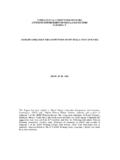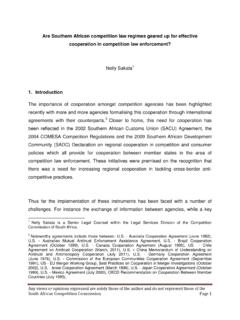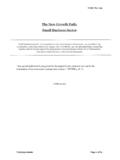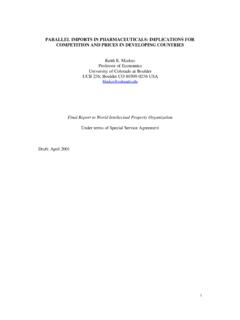Transcription of Country Focus: Brazil Brazil welcomes international ...
1 2 Southern Hemisphere Forest Industry JournalSummer 2004-05 Country Focus: BrazilI. Country REVIEWS ignificant resource wealth This SouthAmerican Country , which is nearly as large ascontinental , is very rich in natural are large mineral deposits in iron and has competitive advantages in many agriculturalareas, including coffee, soybeans, oranges, sugar,tobacco and coca. In addition, there are largelivestock herds and a growing development of woodproducts pulp & paper, lumber, plywood / veneerand composite panels. It has great biological growthrates and, due to implemented-research, some ofthe highest plantation forestry productivity in : - Brazil s economy contains large andwell-developed agricultural, forestry, mining,manufacturing and services sectors.
2 The economyovershadows all the other South Americancountries with an expanding presence in worldmarkets. Brazil has taken steps to create structuralreform and fiscal adjustment with positive resultssince the late 1990 s. The Brazilian currency wasun-pegged from the US$ in 1999 and the subsequentdevaluation helped boost economic growth. Therewas positive economic growth in 2000 of percent, which diminished in 2001-2003 as the CentralBank raised interest rates to combat inflation and aslowdown in major export , the economy is in better condition thanoutward appearances indicate. Government policyhas given priority to reforming complex tax codes,to cutting back an expensive civil service pensionsystem, and continuing to fight inflation.
3 The newPresident, Luiz Inacio Lula da Silva, started with ayear of austerity to restore investor confidence andin 2003 there was some relaxing of interest ratesand higher growth. The Brazilian real (R$) has beenvery stable, increasing in value from in early2003 to currently. This exchange level ishurting most export industries. Most Brazilianeconomists anticipate a growth of 3-4 per cent in2004, initiated by booming exports and as aconsequence domestic consumption andinvestment increases. Brazil requires more directforeign welcomes international visitors andBrazil welcomes international visitors andnew investment partners*new investment partners** Extracts from Brazil Plantation Forest Study TourNotes, April 18 25 2004 organized and conductedby RH Donnelly & Associates, Mark Willhite, andRobert Flynn.
4 (a second Tour is currently beingorganized, for more details visit : FOREST SECTOR IN BRAZILO verviewThe forestry sector is of growing importance inBrazil. It accounts for US $ billion annually andsome per cent of national GDP. In 2002, itcontributed 7 per cent of the exports almost evenlydivided between paper and paper (4 per cent) andwood products (3 per cent). It employed millionindividuals or 9 per cent of the Brazilian labor wood sources in 2002 were 100 million cubicmetres of plantation supply and 200 million cubicmetres of tropical native forest supply. The end usewas principally energy with 15 per cent convertedinto manufactured products:History of Plantation ForestryIn 1966, the Brazilian federal government createda fiscal incentive program for plantationestablishment.)
5 The law encouraged reforestationin the southern part of the Country , which wouldprovide a reliable source of raw material for forestindustry development. This incentive programlasted until 1987, and helped Brazil become theworld leader in plantation forestry for fast-growingSouthern pine and Eucalyptus early years of the program involved pineplantations but by 1971 Eucalyptus had become thedominant species. Although approved applicationsfor the incentive program were higher, theplantations actually implemented were in theneighborhood of million hectares during thisperiod (1967 - 1986). The actual size of theplantation-base, even today, is under dispute andis understated for various reasons (see graph P3).
6 The major measurement problem is that there isno recent or comprehensive national inventory ofthe plantations in Brazil . Some figures would berelatively easy to update, for example the state ofSao Paulo has recently published an inventory ofplantation area. The current eucalyptus plantationarea in that state is 676,000 hectares, orBrazil s Plantation Forest Base - 2003 Softwood (31 per centhectaresSouthern / tropical million Parana millionTotal millionHardwood (63 per cent) million millionTotal hardwood millionTotal millionSource: ABIMCI and other industry groups, 2003 Southern Hemisphere Forest Industry Journal 3 Verano 2004-05 Country Focus: Brazil100,000hectares higher thanthe figure cited in the tablebelow for 2000. A pineinventory in Stanta CatarinaState three years agoindicated similar resultswith an additional 100,000hectares over and above thestated figures in the tablebelow.)
7 In other states it ismuch more difficult to getreliable estimates of plantedareas. This is especiallytrue in regions where smalllandowners are plantingtrees in "landowner-assistance" programs("fomentos" tree farming). Itis estimated that the totalarea of eucalyptusplantations in Brazil has likelyincreased from the millionhectares shown in the followingtable to about million hectaresand pine in the range of millionhectares in early 2004 Plantation Location by StateSoftwood PlantationsThe softwood plantations inBrazil include about millionhectares of Southern pine speciesin the southern part of thecountry, and 400,000 hectares oftropical pines largely from SaoPaulo state northwards.
8 Also,there are perhaps 100,000hectares of Parana pine (Araucariaangustifolia) planted in SantaCatarina and Parana states, whichcontribute very little to theregion's current wood supply. Allof these softwood plantations areprivately the south (Parana, SantaCatarina and Rio Grande do SulStates), the original pineplantations were approximately70 per cent loblolly (Pinus taeda) and 30 per centslash pine ( ). Today these plantations arebeing replaced, in most instances, with 100 per centloblolly pine. There is no Radiata pine in Brazil , asit proved unsuited to available forestation all of the mature pine plantations in Brazilwere planted between the years 1966 - 1986, underthe government tax incentive program. While themajor companies planted large commercial pineforests to supply particular mills, certain otherlandowners planted to gain the tax benefits.
9 Theselatter individuals and small companies typicallyused the least expensive seed available, and plantedeither where they already had land, or where itcould be obtained cheaply. Typically these lower"intensity forests' lacked adequate management,particularly intermediate thinnings. Thisobservation needs to be considered in viewing/evaluating Brazilian plantation '000 haPer cent'000 haPer Grosso do , Grande du , , : Eucalyptus and Pine Plantation by State in 2000 Pine Plantation OwnershipThe pine ownership is moderately is the largest pine plantation owner with186,000 hectares. With the next largest Global ForestPartners (formerly UBS a forest investment group)second holding roughly 33 per cent of the Klabinarea.
10 The distribution of pine plantations in Brazilis much less concentrated than in Chile, where thetop two companies own about 60 per cent of theconifer plantation resource. In Brazil , the top fivepine plantation owners in total own about 20 percent of the softwood area. This suggests that Brazilis more accessible for new forest products PlantationsThe more than three million hectares ofplantations - owned by Brazilian industry (pulp andpaper, wood products and charcoal)-- represent thelargest Eucalyptus plantation-base in the plantations include some areas with thehighest growth rates of any plantation-basedindustry. It is the result of many years of intensivegenetic/silvicultural development work carried outby the pulp and paper companies initiated in the1970's.








